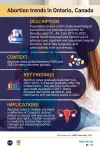(Press-News.org) Once-weekly treatment with tirzepatide can produce clinically meaningful and sustained weight loss for at least 3 years in adults with overweight or obesity who do not have diabetes, according to new research being presented at this year’s European Congress on Obesity (ECO) in Malaga, Spain (11-14 May). The findings also indicate that females and those without obesity-related complications may be more responsive to tirzepatide treatment.
The study, led by Dr Luca Busetto from the University of Padova in Italy and colleagues from Eli Lilly and Company that manufacture tirzepatide, is a continuation of the SURMOUNT-1 phase 3 trial of tirzepatide, a medication approved in the EU and USA for obesity and type 2 diabetes treatment.
“Our long-term analysis of tirzepatide establishes that clinically relevant weight loss can be sustained for up to 3 years in a diverse population of adults with overweight or obesity but not diabetes, regardless of age, BMI, and duration of obesity at the outset of the study”, said Dr Busetto. “But not everyone responds to medication to the same degree and we identified a greater chance of successful weight loss in a group with a higher proportion of females and those with no medical conditions linked to obesity.”
Tirzepatide works by mimicking the glucagon-like peptide-1 (GLP-1) and glucose-dependent insulinotropic polypeptide (GIP) hormones that are naturally secreted by the gut after a meal, which stimulates insulin secretion. It also reduces appetite by slowing down the time it takes the stomach to empty and interacting with areas in the brain harbouring GLP-1 receptors to signal fullness or satiety.
Tirzepatide was approved in November 2023 by the US Food and Drug Administration (FDA) (Zepbound) and in the EU in June 2024 (Mounjaro) for weight management in adults with obesity or overweight with at least one weight-related condition (such as high blood pressure, type 2 diabetes or high cholesterol).
In 2022, the SURMOUNT-1 trial initially found that adults randomised to tirzepatide for 72 weeks lost on average 15% to 21% of their initial weight depending on the dose [1]. This new analysis focuses on 700 of these participants (64% females, average age 48 years) randomised to receive tirzepatide (5, 10, or 15 mg) who were treatment adherent (at least 75% doses received), all of whom initially had either obesity (body mass index, or BMI, of greater than 30kg/m²), or overweight (a BMI of at least 27 kg/m²) and prediabetes.
The researchers examined the average percentage change in body weight from randomisation to week 176 (3 years) as well as time to reach 20% weight reduction to classify participants into three groups.
The associations between participants’ group and characteristics at the start of the study as well as weight loss plateau outcomes were then assessed. Weight loss plateau was defined as less than 5% weight change over 3 months after initial body weight reduction and over all subsequent 3-month intervals. The groups were comparable in average age, duration of obesity, current smoker status, and BMI.
The analysis identified three patterns of weight loss trajectories: participants in Group 1 (248) experienced a relatively steady weight reduction, losing around 10% of their body weight, and reached an early weight loss plateau; those in group 2 (226) experienced faster early body weight reduction (losing around 20%) and later weight loss plateau; while group 3 (226) had the fastest body weight reduction (losing about 30%) and the longest time to weight plateau (see figure in notes to editors).
As Dr Busetto explains: “Adults in Group 1 were on average almost 10% lighter than their initial body weight after 3 years. Whereas participants in Group 3, with the highest proportion of females and those with no medical conditions linked to obesity, lost another 20%, so their overall average weight loss was about 31%.”
Additionally, the percentage reaching a weight loss plateau at the end of the 3-year treatment period differed significantly between the groups, ranging from 87.6% of participants in Group 2 (198/226) to 87.1% of Group 1 (216/248), and 81.4% (184/226) of Group 3.
Among those who hit a weight loss plateau by the end of the study, the majority of participants in Group 1 and 2 reached a weight plateau at an average of 24 weeks (74.5% [161] and 48.0% [95] respectively) when compared to Group 3 (17.4%; 32). In contrast, the majority of participants in Group 3 reached a weight plateau much later, between week 36 and 48 (82.7%; 152).
“Everyone hits a weight loss plateau at some point, no matter which weight loss intervention they use”, explained Dr Busetto. “GLP-1 and GIP are just two of eight hormones that control hunger and weight, and eventually, the other hormones signal the body’s protective mechanisms to make changes to prevent more weight loss.”
He added: “Despite identifying three different patterns of weight loss trajectories, most participants maintained clinically meaningful weight loss over 3 years regardless of age, duration of obesity and BMI. Even modest weight loss can lead to important health benefits. Losing at least 5% of body weight cuts the risk of developing diabetes and meaningfully improves blood pressure and cholesterol. Losing 15% of body weight is the sweet spot at which people tend to reap most health benefits.”
He concluded: “The findings could provide deeper insights into the efficacy of tirzepatide across different demographics and medical histories, potentially allowing for more individualised treatment plans and goals.”
The trial uncovered no new safety issues; the most common side effects were nausea, diarrhoea, and constipation.
END
Tirzepatide can produce clinically meaningful weight loss for at least 3 years in adults with overweight or obesity who don’t have diabetes
2025-04-11
ELSE PRESS RELEASES FROM THIS DATE:
Common respiratory condition nearly triples the risk of death in adults, new study finds
2025-04-11
Common respiratory condition nearly triples the risk of death in adults, new study finds
A major study presented today at ESCMID Global 2025 has revealed that adults with respiratory syncytial virus-associated acute respiratory infection (RSV-ARI) face a 2.7-fold higher risk of death within one year compared to the general population.1
The findings underscore the significant, yet often under-recognised, long-term health and economic burden of RSV-ARI in adults, particularly among those with underlying conditions such as chronic obstructive pulmonary disease (COPD) and asthma.
RSV-ARI refers ...
New research shows evidence of children’s gender biases reflected in their facial emotional expressions
2025-04-11
New research recently published in Archives of Sexual Behavior suggests children’s gender biases can be reflected in their facial emotional expressions.
Psychology professor Doug VanderLaan and his colleagues at the University of Toronto Mississauga, studied 296 children (148 boys and 148 girls) in Canada between the ages of four and nine years old while Wang Ivy Wong, Karen Kwan and their colleagues at the Chinese University of Hong Kong, and The Hong Kong Polytechnic University studied 309 children (155 boys and 154 girls) in Hong Kong. All children watched four short stories that included five illustrations with pre-recorded audio narratives. ...
Crustal brines at an oceanic transform fault
2025-04-11
Woods Hole, Mass. (April 11, 2025) - Being a geophysicist can sometimes feel like being a detective —uncovering clues, and then building a case based on the evidence.
In a new article published in Science Advances, a collaborative team led by the Woods Hole Oceanographic Institution (WHOI), presents a never-before-seen image of an oceanic transform fault from electromagnetic (EM) data collected at the Gofar fault in the eastern Pacific Ocean. The National Science Foundation funded work reveals ...
The Journal of Nuclear Medicine Ahead-of-Print Tip Sheet: April 11, 2025
2025-04-11
Reston, VA (April 11, 2025)—New research has been published ahead-of-print by The Journal of Nuclear Medicine (JNM). JNM is published by the Society of Nuclear Medicine and Molecular Imaging, an international scientific and medical organization dedicated to advancing nuclear medicine, molecular imaging, and theranostics—precision medicine that allows diagnosis and treatment to be tailored to individual patients in order to achieve the best possible outcomes.
Summaries of the newly published research articles are provided below.
Tracing Prostate Cancer Beyond the Usual Path
Researchers uncovered ...
A fluid battery that can take any shape
2025-04-11
Using electrodes in a fluid form, researchers at Linköping University have developed a battery that can take any shape. This soft and conformable battery can be integrated into future technology in a completely new way. Their study has been published in the journal Science Advances.
“The texture is a bit like toothpaste. The material can, for instance, be used in a 3D printer to shape the battery as you please. This opens up for a new type of technology,” says Aiman Rahmanudin, assistant professor at Linköping University.
It is estimated that more than a trillion gadgets will be connected to the Internet in ten years’ time. In addition to traditional ...
Light that spirals like a nautilus shell
2025-04-11
Beams of light that can be guided into corkscrew-like shapes called optical vortices are used today in a range of applications. Pushing the limits of structured light, Harvard applied physicists in the John A. Paulson School of Engineering and Applied Sciences (SEAS) report a new type of optical vortex beam that not only twists as it travels but also changes in different parts at different rates to create unique patterns. The way the light behaves resembles spiral shapes common in nature.
The ...
Transforming doors into gateways to the virtual world: the future of mixed reality!
2025-04-11
Ikoma, Japan—People seeking to feel fully immersed in virtual environments will soon be able to experience a revolutionary approach to spatial computing that bridges the gap between real and digital worlds. A collaborative research team from NTT DOCOMO, Inc. and Nara Institute of Science and Technology (NAIST), Japan, has developed a novel mixed reality (MR) technology that transforms how users interact with virtual spaces by using everyday real-world doors as natural transition points.
Virtual reality (VR) and MR technologies have ...
AACR announces recipients of the 2025 AACR June L. Biedler Prize for Cancer Journalism
2025-04-11
PHILADELPHIA – The American Association for Cancer Research (AACR) is pleased to announce the recipients of the 2025 AACR June L. Biedler Prize for Cancer Journalism in the following categories:
Magazine
“Targeting Cancer, Sparing Patients”
By Jyoti S. Madhusoodanan (Photo), Scientific American
Newspaper
“Fighting stigma, fighting cancer: The rising threat of male breast cancer in Kenya”
By Pauline Ongaji Ogada (Photo), Nation
Online/Multimedia
“Farewell, my stomach”
By Teresa Firmino (Photo) and Joana Martins Gonçalves (Photo), Publico
“Women ...
Human-AI relationships pose ethical issues, psychologists say
2025-04-11
It’s becoming increasingly commonplace for people to develop intimate, long-term relationships with artificial intelligence (AI) technologies. At their extreme, people have “married” their AI companions in non-legally binding ceremonies, and at least two people have killed themselves following AI chatbot advice. In an opinion paper publishing April 11 in the Cell Press journal Trends in Cognitive Sciences, psychologists explore ethical issues associated with human-AI relationships, including their potential to disrupt human-human relationships and give harmful advice.
“The ...
Abortion rates remain relatively stable in Canada, while rates spike in UK, Europe, and US
2025-04-11
Vancouver, BC, April 11, 2025 – A new study finds that, unlike countries across the UK and Europe, abortion rates did not spike in Ontario, Canada from 2020-2022.
Following decades-long declines in nearly all high-income settings, abortion rate trends reversed between 2020 and 2022 in many countries. For example, 2022 and 2023 saw the highest abortion rates on record in Scotland, England, and Wales.
Researchers from the University of British Columbia and ICES found that, after accounting for changes in the abortion rate when the ...




